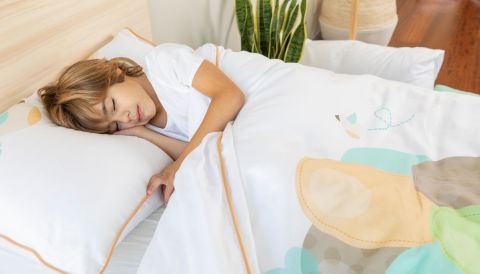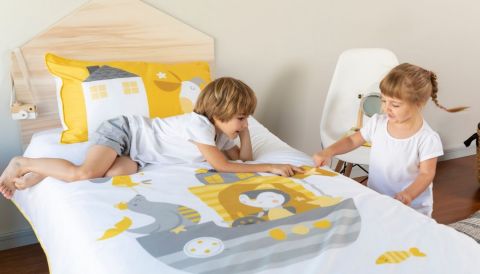Decorating your child’s bedroom can be such fun - whether you’re in the nesting stage of pregnancy and creating a space for your newborn, or as something you and your child are doing together as they grow.
One thing we’ve noticed is that it’s easy to get swept up in the latest trends, themes or your child’s favourite colour of the moment.

But, something that often goes unconsidered, is how bedroom colour schemes can affect your child - and that includes how it can impact their sleep.
That’s why we’re going to dive into the world of colour psychology today, to help you understand the role of colour in child development, which colours are believed to promote quality sleep and how to choose a great bedroom colour scheme for your child and home.
We’ll also cover the basics of a good sleep routine and other aspects of the bedroom environment that can help to promote quality sleep for your little ones.
The importance of colour for child development
Babies are not born with fully-developed vision - and this includes their ability to experience colour. While people commonly believe that babies only see in black and white, this is a myth and “studies have found that newborns can see large, intense patches of red on a grey background.”
As their cells mature over time, so can their ability to see colour, although colour saturation does play an important role in how well they can view it. By two months, babies can distinguish between red and green. By around five months of age, they can see a full spectrum of colour well and their colour sensitivity will continue to improve over the first year.

Understanding the concept of colour is an essential building block to help children interpret the world around them and particularly, it informs how they learn. Our kids’ worlds are full of colour, with it impacting their experience of life in terms of aesthetics, mood, emotional wellbeing, productivity, learning and behaviour.
In fact, colour recognition is vital for:
- Categorisation and organisation
- Fine motor skills
- Description and communication
- Creative expression
Because children find it easier to distinguish between more saturated colours initially, using these around them is helpful for cognitive stimulation and development. That makes highly-saturated shades ideal for toys, games, educational material and other forms of play.
However, it’s important to note that the same does not necessarily apply when it comes to providing a soothing sleep environment. Therefore, when you’re planning your child’s bedroom - balance is key . While you shouldn’t shy away from including a variety of hues, textures and colours in the room, the dominant and more permanent ones should be those conducive to restful sleep.
So, what is a good night’s sleep exactly?
A good night’s sleep, whether for your kids or yourself involves two key things: getting to sleep easily and then staying asleep.

If your kids aren’t getting a good night’s sleep, they’ll find it difficult to wake up on their own in the mornings, and when they do wake, they’ll appear reluctant and groggy. You’ve probably experienced first-hand the difference between a sleep-deprived child and a sleep-deprived adult: kids seem to kick into overdrive, while we adults slow right down!
A well-rested child will be able to concentrate at school, will get on well with others, will have more stable moods and be motivated to enjoy activities.
There’s no doubt that restful sleep = a happier child, and therefore happier mums and dads.
What colours are soothing for sleep?
When you’re choosing bedroom colour schemes for your kids, you’re ideally looking for colours that evoke calmness and relaxation. Let’s look at a few of our favourite soothing colours now:
Yellow
Yellow is a beautiful and warm choice in small doses or paler shades. While children may naturally prefer bright yellow, it is energetic and can raise tension in a room. Of course, anxiety is not conducive to a good night’s sleep, so if you’re painting walls, then softer hues are the way to go.
Green
Green is hands-down one of the most agreed-upon colours for a relaxing environment. This is because it reflects our natural response to being in nature. Think about all the words we tend to associate with green:
- Natural
- Organic
- Growth
- Life
- Balance
- Peaceful
It’s clear why this makes a good choice for bedroom colour schemes - for kids and adults alike.
Blue
Blue is another favourite because it evokes serenity. You need to watch for the greyer shades that may inspire sadness, and the rule is that the darker the blue, the less you should feature it in the room.
Pink
Thank goodness! I can hear the sighs of relief from parents of little girls (or boys) everywhere whose favourite colour is pink. Pale pink shades are perfectly calming for bedroom colour schemes.
White
White has long been associated with calm and peace. It, therefore, provides the perfect complement to any of these other colours when developing bedroom colour schemes, or you could opt for small doses of neutrals like soft greys, taupes and beiges.
What colours should you avoid for a soothing sleep?
So, now you understand the colours best suited to kids bedroom colour schemes, it’s time to consider those at the other end of the spectrum - colours best avoided in large doses. Those include:
Red
Red is stimulating, so while it is a good colour for children in general and many of them love it, it may not be conducive to a good night’s sleep. Therefore, red should only be used as an accent colour if you include it at all.
Purple
Purple inspires too much creativity to be a restful bedroom colour. In fact, this Travelodge survey found that it provokes nightmares! You may be able to use pastel shades in small doses, but try to steer clear of an all-out purple theme.
Oh, and when you’re using colour across large surfaces like walls, it’s always best to choose flat paint instead of gloss. High-level shine reflects light, while matte or satin sheens tend to have a softening effect.
What other factors help promote sleep in a child’s bedroom?
When it comes to decorating a kid’s bedroom, there are a few design elements other than colour that can help promote quality sleep.
For example:
- Rounded shapes for furniture or decor rather than angular ones, to promote relaxation
- Carpeting is more inviting than hard surfaces (if you don’t have carpet, you can always add a rug to soften the environment and reinforce bedroom colour schemes)
- Dim lighting is essential to reinforce the body’s natural circadian rhythms. If your child’s room has a nightlight, it should be one with red based light which won’t inhibit melatonin production and thus trick your child’s body into believing it’s daylight.
Examples of bedroom colour schemes we love
Green, pink & white
Less is certainly more in this kids bedroom. A black, white and timber foundation is brought to life by a splash of green and pink. This bedroom colour scheme is an excellent example of demonstrating that you can add colour to a wall, without needing to paint the entire room - which can quickly become overwhelming.
White, blue & yellow
Even though the majority of the room is white and grey, pops of mustard yellow and dark blue immediately draw the eye. These hues are bold enough to be attractive to kids but soothing enough not to be a source of stimulation as they try to sleep.
Pink, white & grey
This bedroom colour scheme proves it’s possible to make pink the theme colour, without needing everything in the room pink! Shapes, pattern and texture add interest and the placement of a few key decor items in lighter shades of pink help to soften the room.
Pink, yellow & grey
It seems an unlikely combination, but this is another example we love where pink doesn’t dominate the room. Just a few carefully placed mustard yellow soft furnishings keep the bedroom colour scheme balanced.
Grey & white
Pattern and texture are the predominant features of this room, proving just how much you can achieve with minimal colour. The panelled ceiling and wood bed frame add a “camping in the woods” vibe that is playful yet soothing.
White, black & blue
This classic combination of colour is given new life thanks to the fun bedding and wall art choices. When you start with a neutral colour scheme, it’s easy to see how this can be a great transitional bedroom as your child grows.
Blue & white
The blue panelled wall could easily form the foundation of a gender-neutral bedroom. Some of the more “adult” choices in the room are made playful with storybook storage and stuffed animal wall art.
Yellow & white
This gorgeous bedroom features our very own Wriggly Toes character - Purdy the Penguin . Pops of yellow are perfect for bringing life to a neutral foundation of white, with natural textures like timber and woven straw creating a homely feel. You can also see how the rounded decorative elements soften the room and add some fun
White & green
Another bedroom featuring a Wriggly Toes character - this time it’s Ron the Raccoon . Again, this demonstrates how pulling out one feature colour from your choice of bedding and then injecting it around the room can form the basis of your bedroom colour scheme. All it takes is four or five items in soft mint green to make it inviting for your little one.
Where to find inspiration for your kids’ bedroom colour schemes:
When decorating your kids’ bedrooms, there’s no shortage of inspiration out there, and it’s easy to get lost browsing ideas on Pinterest for hours on end. But, if you’d like something more individual and reflective of who your child is, you could try these ideas as a foundation for the room’s decor:
- Start by choosing one piece for their room, like a bedding set or a rug and then build on it
- Start with your kid’s favourite colour
- Start with a particular pattern that they show a preference for
Alternatively, you could start with one of their favourite things like:
- A book or movie - whether that’s a particular character, scene or line from it
- Their biggest interest whether that be dinosaurs, space, or ballet for instance
- A place that intrigues them - the beach, jungle or a specific city, like Paris
- Something they love to do, like reading, craft, board games or Lego
How to include kids in bedroom decorating
“ According to Dulux research , 92% of kids say that they would spend more time in their bedrooms if they had helped to plan it themselves, as doing so allows them to develop a strong sense of ownership.”
That sounds like a good incentive to get kids involved in choosing bedroom colour schemes! You could allow them to choose between a couple of colours, or several shades of one colour if you would like to retain some control over the finished product.
Soft furnishings like bedding are great to give kids a say in. Because they are less permanent, you can easily update when the time comes. Why not let them choose their favourite character from the Wriggly Toes range, for example!
Another way of involving them in the decorating process is to encourage your kids to create the artwork you will hang on the walls.
Other ways to promote good sleep routines
Of course, even the most soothing bedroom colour schemes won’t be helpful if your kids don’t have healthy sleep routines. For instance, creating a positive bedroom routine that starts around 20 minutes before bed may include:
- “Your child plays quietly for 15-20 minutes – this could include reading with you.
- You and your child go into the bedroom.
- You and your child have a brief cuddle and kiss.
- You put your child into bed.”
- Going to bed at the same (age-appropriate) time every day
The bedroom should also be quiet and neither too hot, nor too cold. Using organic cotton bedding is a great way to help regulate body temperature in our warm Australian climate.
We hope this has helped you find some inspiration to decorate your kids’ bedrooms in a way that best promotes quality sleep. The key takeaways here are:
Soft shades of yellow, green, blue, pink and white create soothing environments Kids want to be involved, so let them have a say in a bedroom that reflects their individuality
And, if you’re looking for some bedding to complement those beautiful bedroom colour schemes, take a look at our complete range of organic kids bedding sets featuring unique and playful characters!

